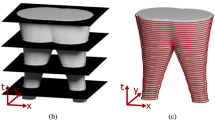Abstract
The paper presents a novel method for automatic segmentation of the low-contrast shadowgraphs that are acquired during the examination of the laser-induced shockwaves evolution. The method is based on two-stage, active-contour algorithms. First stage ensures global robustness, but it is locally inaccurate. It is implemented by traditional snake based on texture cues. The outcome serves as initialization to the second refining stage detection. In the second stage the detection is robust only locally and improves local accuracy. To do this, we introduce a greedy-snake algorithm. Local optimum is searched with respect to responses of steerable filtering and edge orientation similarity by exploiting the Bayesian formalism. The paper presents validation of the method on large data set of low-contrast shadowgraphs by comparison to the manual segmentation technique. The obtained results demonstrate overall good performance, robustness, high accuracy, and objectivity of the method.










Similar content being viewed by others
References
Thiel, M., Nieswand, M., Dörffel, M.: The use of shock waves in medicine-a tool of the modern OR: an overview of basic physical principles, history and research. Minim. Invasive Ther. Allied Technol. MITAT Off. J. Soc. Minim. Invasive Ther. 9, 247–253 (2000)
Diaci, J., Možina, J.: Measurement of energy conversion efficiency during laser ablation by a multiple laser beam deflection probe. Ultrasonics 34, 523–525 (1996)
Chaurasia, S., Leshma, P., Tripathi, S., Murali, C.G., Munda, D.S., Sharma, S.M., Kailas, S., Gupta, N.K., Dhareshwar, L.J.: Simultaneous measurement of particle velocity and shock velocity for megabar laser driven shock studies. BARC Newslett. 317, 13–21 (2010)
Koenig, M., Faral, B., Boudenne, J.M., Batani, D., Benuzzi, A., Bossi, S., Remond, C., Perrine, J.P., Temporal, M., Atzeni, S.: Relative consistency of equations of state by laser driven shock waves. Phys. Rev. Lett. 74, 2260 (1995)
Lauterborn, W., Vogel, A.: Shock wave emission by laser generated bubbles. In: Bubble Dynamics and Shock Waves, pp. 67–103. Springer, Berlin (2013)
Noack, J., Vogel, A.: Single-shot spatially resolved characterization of laser-induced shock waves in water. Appl. Opt. 37, 4092–4099 (1998)
Kleine, H., Grönig, H.: Color schlieren methods in shock wave research. Shock Waves 1, 51–63 (1991)
Gregorčič, P., Možina, J.: High-speed two-frame shadowgraphy for velocity measurements of laser-induced plasma and shock-wave evolution. Opt. Lett. 36, 2782–2784 (2011)
Settles, G.S.: Schlieren and shadowgraph techniques: visualizing phenomena in transparent media. Springer, Berlin (2001)
Vogel, A., Apitz, I., Freidank, S., Dijkink, R.: Sensitive high-resolution white-light Schlieren technique with a large dynamic range for the investigation of ablation dynamics. Opt. Lett. 31, 1812–1814 (2006)
Perhavec, T., Diaci, J.: A novel double-exposure shadowgraph method for observation of optodynamic shock waves using fiber-optic illumination. Stroj. Vestn. J. Mech. Eng. 56, 477–482 (2010)
Gregorčič, P., Diaci, J., Možina, J.: Two-dimensional measurements of laser-induced breakdown in air by high-speed two-frame shadowgraphy. Appl. Phys. A 112, 49–55 (2012)
Kokaj, J.O.: Morphological image processing of a bubble in laser-induced shock-wave lithotripsy. In: Proceedings of Intelligent Robots and Computer Vision XIX, pp. 98–106 (2000)
Wang, F., Yang, Z.W., Kong, D.R., Jia, Y.F.: Research on the high-speed object shadowgraph Image processing method based on adaptive threshold segmentation. Appl. Mech. Mater. 325–326, 1571–1575 (2013)
Otsu, N.: A threshold selection method from gray-level histograms. Automatica 11, 23–27 (1975)
Zhang, Y., Brady, M., Smith, S.: Segmentation of brain MR images through a hidden Markov random field model and the expectation-maximization algorithm. Med. Imaging IEEE Trans. 20, 45–57 (2001)
Vezhnevets, V., Konouchine, V.: GrowCut: interactive multi-label ND image segmentation by cellular automata. In: Proc. of Graphicon, pp. 150–156 (2005)
Boykov, Y., Funka-Lea, G.: Graph cuts and efficient N-D image segmentation. Int. J. Comput. Vis. 70, 109–131 (2006)
Chan, T.F., Vese, L.A.: Active contours without edges. Image Process. IEEE Trans. 10, 266–277 (2001)
Chiu, W.-Y., Tsai, D.-M.: Dual-mode detection for foreground segmentation in low-contrast video images. J. Real-Time Image Process. 9, 647–659 (2012)
Wong, S.-F., Wong, K.K.Y.: Robust image segmentation by texture sensitive snake under low contrast environment. In: Proceedings of the International Conference on Informatics in Control, Automation and Robotics, pp. 430–434 (2004)
Yingjie, Z., Liling, G.: New approach to low contrast image segmentation. In: The 2nd International Conference on Bioinformatics and Biomedical Engineering, 2008. ICBBE 2008, pp. 2369–2372 (2008)
McInerney, T., Terzopoulos, D.: Deformable models in medical image analysis. Mathematical Methods in Biomedical Image Analysis, 1996, Proceedings of the Workshop on. pp. 171–180. IEEE (1996)
Blake, A.: Active contours: the application of techniques from graphics, vision, control theory and... Springer, [S.l.], Berlin (2012)
Tian, Y., Duan, F., Zhou, M., Wu, Z.: Active contour model combining region and edge information. Mach. Vis. Appl. 24, 47–61 (2013)
Kass, M., Witkin, A., Terzopoulos, D.: Snakes: active contour models. Int. J. Comput. Vis. 1, 321–331 (1988)
Ivins, J., Porrill, J.: Everything you always wanted to know about snakes (but were afraid to ask). Technical Report, University of Sheffield (2000)
Lam, K.-M., Yan, H.: Fast greedy algorithm for active contours. Electron. Lett. 30, 21–23 (1994)
Lindeberg, T.: Edge detection and ridge detection with automatic scale selection. Int. J. Comput. Vis. 30, 117–156 (1998)
Geusebroek, J.-M., Smeulders, A.W., van de Weijer, J.: Fast anisotropic Gauss filtering. Computer Vision–ECCV 2002, pp. 99–112. Springer, Berlin (2002)
Radeva, P., Serrat, J.: Rubber snake: implementation on signed distance potential. In: Proceedings of Vision Conference SWISS’93, pp. 187–194 (1993)
Acknowledgments
We would like to thank Dr.Matej Kristan from Visual Cognitive Systems Laboratory, University of Ljubljana, for fruitful discussions and help.
Author information
Authors and Affiliations
Corresponding author
Rights and permissions
About this article
Cite this article
Pribošek, J., Gregorčič, P. & Diaci, J. Automating shockwave segmentation in low-contrast coherent shadowgraphy. Machine Vision and Applications 26, 485–494 (2015). https://doi.org/10.1007/s00138-015-0683-0
Received:
Revised:
Accepted:
Published:
Issue Date:
DOI: https://doi.org/10.1007/s00138-015-0683-0




